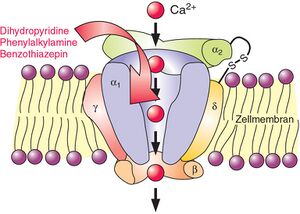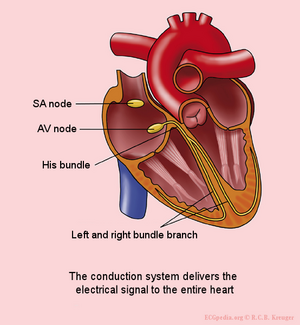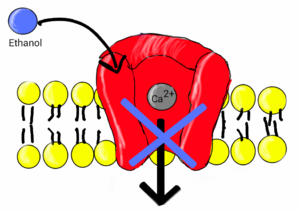Calcium Channel Blockers: Difference between revisions
No edit summary |
(I have added the mechanism of action of calcium channel blockers and inserted a table showing drugs included in two categories. I have also updated some previously written information and added references from recent studies.) |
||
| Line 26: | Line 26: | ||
# Subarachnoid hemorrhage | # Subarachnoid hemorrhage | ||
# Hypertrophic cardiomyopathy | # Hypertrophic cardiomyopathy | ||
# Coronary spasm | |||
# Raynaud phenomena<ref>McKeever RG, Hamilton RJ. Calcium channel blockers. https://europepmc.org/article/nbk/nbk482473#__NBK482473_dtls__</ref> | |||
== Categories == | == Categories == | ||
| Line 70: | Line 72: | ||
[[File:Kirill-4SUV4Hc0IEA-unsplash.jpg|thumb|Exercising outdoor|alt=|433x433px]] | [[File:Kirill-4SUV4Hc0IEA-unsplash.jpg|thumb|Exercising outdoor|alt=|433x433px]] | ||
Exercise Capacity: CCBs do not have a major effect on [[Therapeutic Exercise|exercise]] capacity and may help people with [[angina]] better tolerate exercise. As a result of the [[Cardiovascular System|blood vessels]] throughout the body dilating, [[Blood Physiology|blood]] flow into working muscles may be decreased and the [[Lactate Threshold|lactate threshold]] (the point where lactic acid begins to build up in muscles) could be reached earlier, potentially affecting athletic performance. | Exercise Capacity: CCBs do not have a major effect on [[Therapeutic Exercise|exercise]] capacity and may help people with [[angina]] better tolerate exercise. As a result of the [[Cardiovascular System|blood vessels]] throughout the body dilating, [[Blood Physiology|blood]] flow into working muscles may be decreased and the [[Lactate Threshold|lactate threshold]] (the point where lactic acid begins to build up in muscles) could be reached earlier, potentially affecting athletic performance. | ||
Exercise capacity was seen to improve in patients with arterial fibrillation.<ref>https://academic.oup.com/eurheartj/article/35/8/517/623019</ref> | |||
Other Exercise Effects: The non-dihydropyridines CCBs can reduce both resting and maximum [[Heart Rate|heart rate]]<nowiki/>s and decrease heart rate response to exercise. They may also delay or prevent symptoms of myocardial ischemia, or reduced blood flow to the heart. For individuals using those medications, the American College of Sports Medicine recommends exercise testing to determine exercise heart rate.<ref>AZ central Calcium Channel Blockers' Effects on Exercise Capacity Available:https://healthyliving.azcentral.com/calcium-channel-blockers-effects-exercise-capacity-7068.html (accessed 30.3.2022)</ref>See [[Physical Activity and Exercise Prescription]] | Other Exercise Effects: The non-dihydropyridines CCBs can reduce both resting and maximum [[Heart Rate|heart rate]]<nowiki/>s and decrease heart rate response to exercise. They may also delay or prevent symptoms of myocardial ischemia, or reduced blood flow to the heart. For individuals using those medications, the American College of Sports Medicine recommends exercise testing to determine exercise heart rate.<ref>AZ central Calcium Channel Blockers' Effects on Exercise Capacity Available:https://healthyliving.azcentral.com/calcium-channel-blockers-effects-exercise-capacity-7068.html (accessed 30.3.2022)</ref>See [[Physical Activity and Exercise Prescription]] | ||
Revision as of 20:19, 15 November 2022
Original Editor - Lucinda hampton
Top Contributors - Lucinda hampton, Wajeeha Hassan and Kim Jackson
Introduction[edit | edit source]
Calcium channel blockers decrease the amount of calcium entering cardiac and smooth muscle cells by blocking voltage-gated calcium channels. This causes blood vessels to relax and widen (vasodilate) thus improving oxygen supply to the heart.
Calcium channel blockers (CCBs) are used in the management of hypertension, angina pectoris, supraventricular arrhythmias, subarachnoid hemorrhage, pulmonary hypertension, and for the prevention of migraine[1].
They work by preventing calcium from entering the cells of the heart and arteries. Calcium causes the heart and arteries to contract more strongly. By blocking calcium, calcium channel blockers allow blood vessels to relax and open.
Some calcium channel blockers can also slow the heart rate, which can further lower blood pressure[2].
Mechanism Of Action[edit | edit source]
Calcium-channel blockers bind to L-type calcium channels located on the vascular smooth muscle, cardiac myocytes, and cardiac nodal tissue (sinoatrial and atrioventricular nodes). These channels are responsible for regulating the influx of calcium into muscle cells, which in turn stimulates smooth muscle contraction and cardiac myocyte contraction. In cardiac nodal tissue, L-type calcium channels play an important role in pacemaker currents. Therefore, by blocking calcium entry into the cell, there is, vasodilation. Decreased myocardial force generation (negative inotropy), decreased heart rate (negative chronotropic), Decreased conduction velocity within the heart (negative dromotropic).
Indications[edit | edit source]
Following are the indications of calcium channel blockers however these should be taken without being prescribed by your doctor.[3]
- Hypertension
- Arrhythmias
- Angina
- Pulmonary hypertension
- Subarachnoid hemorrhage
- Hypertrophic cardiomyopathy
- Coronary spasm
- Raynaud phenomena[4]
Categories[edit | edit source]
CCBs are often classify into two major categories, either non-dihydropyridines or dihydropyridines, based on their primary physiologic effects.
- The non-dihydropyridines have inhibitory effects on the sinoatrial (SA), and atrioventricular (AV) nodes resulting in a slowing of cardiac conduction and contractility. The are useful for the treatment of hypertension, reducing oxygen demand, and helps to control the rate in tachycardia.
- The dihydropyridines have a little direct effect on the myocardium, and instead, are more often peripheral vasodilators, and are useful for hypertension, post-intracranial hemorrhage associated vasospasm, and migraines.[5]
| Dihydropyridines | Non- Diyhydropyridines |
|---|---|
| Amlodipine | Diltiazem (benzothiazepine) |
| Felodipine | Verapamil (phenylalkamine) |
| Nicardipine | |
| Nifedipine | |
| Nimodipine | |
| Nisoldipine | |
| Isradipine |
Adverse Effects[edit | edit source]
Include:
- Non-dihydropyridines may cause constipation, worsening cardiac output, and bradycardia.
- Dihydropyridines may lead to lightheadedness, flushing, headaches, and peripheral edema.
- Alcohol, combined with a calcium channel blocker, can cause severe side effects and may also affect the way the medication works.[6]
Physiotherapy[edit | edit source]
Exercise Capacity: CCBs do not have a major effect on exercise capacity and may help people with angina better tolerate exercise. As a result of the blood vessels throughout the body dilating, blood flow into working muscles may be decreased and the lactate threshold (the point where lactic acid begins to build up in muscles) could be reached earlier, potentially affecting athletic performance.
Exercise capacity was seen to improve in patients with arterial fibrillation.[7]
Other Exercise Effects: The non-dihydropyridines CCBs can reduce both resting and maximum heart rates and decrease heart rate response to exercise. They may also delay or prevent symptoms of myocardial ischemia, or reduced blood flow to the heart. For individuals using those medications, the American College of Sports Medicine recommends exercise testing to determine exercise heart rate.[8]See Physical Activity and Exercise Prescription
References[edit | edit source]
- ↑ Gad SC. Phthalic Anhydride. Encyclopedia of Toxicology (Third Edition). 2014 Jan 1:934-6. Available:https://www.sciencedirect.com/topics/neuroscience/calcium-channel-blockers (accessed 29.3.2022)
- ↑ Mayo clinic CCBs Available:https://www.mayoclinic.org/diseases-conditions/high-blood-pressure/in-depth/calcium-channel-blockers/art-20047605 (accessed 29.3.2022)
- ↑ https://my.clevelandclinic.org/health/treatments/22316-calcium-channel-blockers
- ↑ McKeever RG, Hamilton RJ. Calcium channel blockers. https://europepmc.org/article/nbk/nbk482473#__NBK482473_dtls__
- ↑ McKeever RG, Hamilton RJ. Calcium channel blockers.2018 Available: https://www.ncbi.nlm.nih.gov/books/NBK482473/(accessed 30.3.2022)
- ↑ Everyday health What Are Calcium Channel Blockers? Available: https://www.everydayhealth.com/calcium-channel-blocker/guide/ (accessed 30.3.2022)
- ↑ https://academic.oup.com/eurheartj/article/35/8/517/623019
- ↑ AZ central Calcium Channel Blockers' Effects on Exercise Capacity Available:https://healthyliving.azcentral.com/calcium-channel-blockers-effects-exercise-capacity-7068.html (accessed 30.3.2022)










